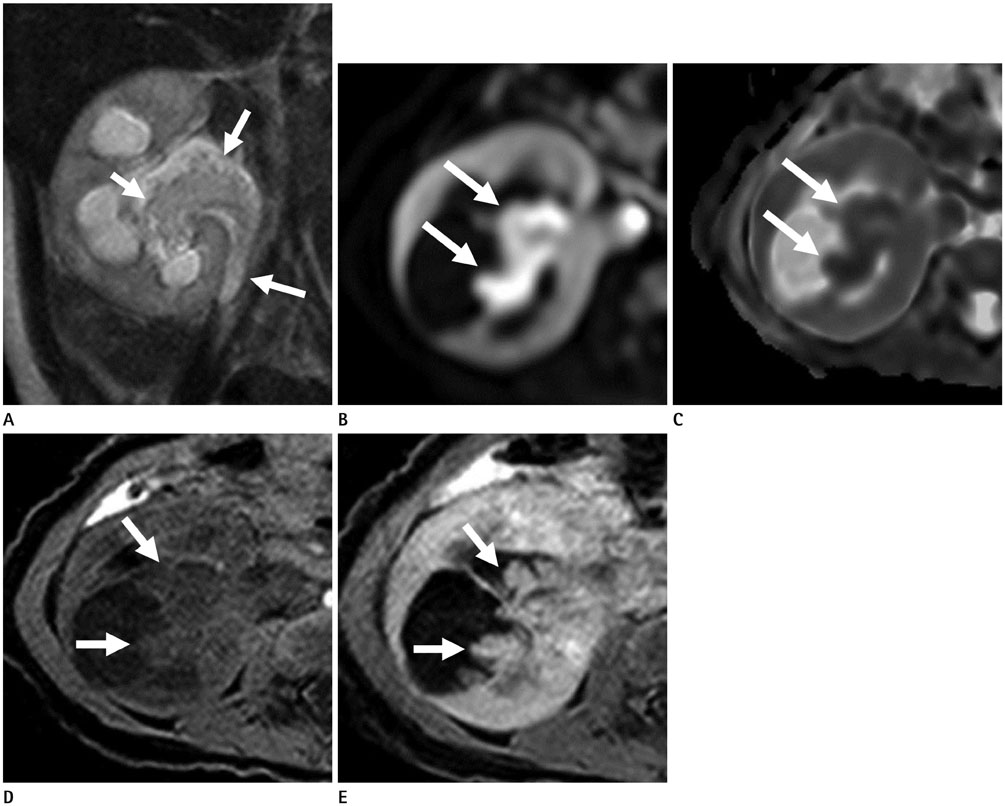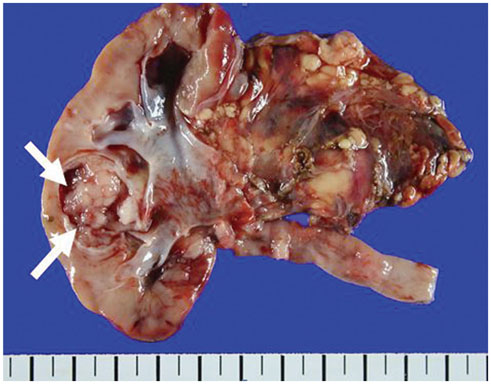J Korean Soc Radiol.
2016 Sep;75(3):198-202. 10.3348/jksr.2016.75.3.198.
Botryoid Wilms' Tumor in a Child Presenting with Gross Hematuria: A Case Report
- Affiliations
-
- 1Department of Radiology and Research Institute of Radiological Science, Severance Children's Hospital, Yonsei University College of Medicine, Seoul, Korea. mjl1213@yuhs.ac
- 2Department of Pediatric Urology, Urological Science Institute, Severance Children's Hospital, Yonsei University College of Medicine, Seoul, Korea.
- KMID: 2349325
- DOI: http://doi.org/10.3348/jksr.2016.75.3.198
Abstract
- We report a unique case of botryoid Wilms' tumor with its characteristic imaging findings in a 5-month-old boy presenting with gross hematuria. In our case, ultrasonography revealed lobulated hyperechoic lesions filling the pelvicalyceal system without parenchymal invasion, mimicking a blood clot. However, magnetic resonance imaging (MRI) demonstrated the exact extent of the lesion with diffusion restriction and delayed enhancement suggestive of a tumor. Despite their rarity, botryoid Wilms' tumors should be included in the differential diagnosis of lobulated renal pelvic lesions presenting as gross hematuria in children, and MRI can suggest the diagnosis.
MeSH Terms
Figure
Reference
-
1. Inoue M, Uchida K, Kohei O, Nashida Y, Deguchi T, Komada Y, et al. Teratoid Wilms' tumor: a case report with literature review. J Pediatr Surg. 2006; 41:1759–1763.2. Nagahara A, Kawagoe M, Matsumoto F, Tohda A, Shimada K, Yasui M, et al. Botryoid Wilms' tumor of the renal pelvis extending into the bladder. Urology. 2006; 67:845.e15–845.e17.3. Xu G, Hu J, Wu Y, Xiao Y, Xu M. Botryoid Wilms' tumor: a case report and review of the literature. World J Surg Oncol. 2013; 11:102.4. Honda A, Shima M, Onoe S, Hanada M, Nagai T, Nakajima S, et al. Botryoid Wilms tumor: case report and review of literature. Pediatr Nephrol. 2000; 14:59–61.5. Mizuno K, Hayashi Y, Tozawa K, Iwatsuki S, Kojima Y, Kohri K. Single-nucleotide polymorphism in WT1 gene in a hyperplastic intralobar nephrogenic rest with botryoid protrusion. Urology. 2010; 76:149–152.6. Tu BW, Ye WJ, Li YH. Botryoid Wilms' tumor: report of two cases. World J Pediatr. 2011; 7:274–276.7. Yanai T, Okazaki T, Yamataka A, Kobayashi H, Lane GJ, Saito M, et al. Botryoid Wilms' tumor: a report of two cases. Pediatr Surg Int. 2005; 21:43–46.8. Lowe LH, Isuani BH, Heller RM, Stein SM, Johnson JE, Navarro OM, et al. Pediatric renal masses: Wilms tumor and beyond. Radiographics. 2000; 20:1585–1603.9. Geller E, Kochan PS. Renal neoplasms of childhood. Radiol Clin North Am. 2011; 49:689–709, vi.10. Kim J. Ultrasonographic features of focal xanthogranulomatous pyelonephritis. J Ultrasound Med. 2004; 23:409–416.




